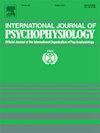Mindfulness meditation alters alpha amplitude without affecting arousal
IF 2.5
3区 心理学
Q3 NEUROSCIENCES
引用次数: 0
Abstract
Mindfulness meditation has experienced a surge in popularity due to its well-documented health benefits, although the mechanisms driving these benefits are not clearly understood. This study explored whether mindfulness of breathing meditation induces changes in brain function and physiological responses related to attention or arousal mechanisms. Electroencephalography (EEG) and skin conductance level (SCL) data were recorded during eyes-closed resting and meditation states in 42 young adults (Mage = 21.05 years; 26 females) across two sessions (pre-training, post-training) six weeks apart. Between sessions, participants were randomly assigned to one of two groups completing a daily 15-min activity involving either mindfulness (n = 21) or music (n = 21; active-control group). Results revealed a significant reduction in alpha amplitude (8–13 Hz) during meditation compared to rest. Additionally, post-training, there was a smaller alpha reduction during meditation in the mindfulness group, particularly in the frontal/posterior region, evidence of a possible trait effect. While SCL remained stable over meditation and rest, a decrease was evident in both groups post-training, indicating reduced arousal. However, no significant associations were found between SCL and global alpha amplitude. Together, these findings suggest mindfulness meditation reduces alpha band activity, likely reflecting enhanced attentional engagement rather than an arousal change, supporting the view of mindfulness meditation as a state of relaxed alertness. The present findings provide new insights into the mechanisms underlying mindfulness meditation, emphasising the importance of alpha band activity in attentional control, which may contribute to its health benefits, including improved emotional regulation and cognitive functioning.
正念冥想在不影响觉醒的情况下改变α振幅
正念冥想因其对健康的益处而受到广泛欢迎,尽管推动这些益处的机制尚不清楚。本研究探讨了呼吸冥想的正念是否会引起与注意力或唤醒机制相关的大脑功能和生理反应的变化。记录42例年轻成人闭眼休息和冥想状态下的脑电图和皮肤电导水平(SCL)数据。26名女性),间隔6周进行两次训练(训练前和训练后)。在两个疗程之间,参与者被随机分配到两组中的一组,每天完成15分钟的活动,包括正念(n = 21)或音乐(n = 21;主动控制集团)。结果显示,与休息相比,冥想时α振幅(8-13赫兹)显著降低。此外,在训练后,正念组在冥想期间的α减少幅度较小,尤其是在额/后区域,这可能是特质效应的证据。虽然SCL在冥想和休息期间保持稳定,但训练后两组的SCL明显下降,表明觉醒程度降低。然而,在SCL和整体α振幅之间没有发现显著的关联。总之,这些发现表明,正念冥想会减少α带活动,这可能反映了注意力的增强,而不是唤醒的变化,这支持了正念冥想是一种放松警觉状态的观点。目前的研究结果为正念冥想的潜在机制提供了新的见解,强调了α带活动在注意力控制中的重要性,这可能有助于其健康益处,包括改善情绪调节和认知功能。
本文章由计算机程序翻译,如有差异,请以英文原文为准。
求助全文
约1分钟内获得全文
求助全文
来源期刊
CiteScore
5.40
自引率
10.00%
发文量
177
审稿时长
3-8 weeks
期刊介绍:
The International Journal of Psychophysiology is the official journal of the International Organization of Psychophysiology, and provides a respected forum for the publication of high quality original contributions on all aspects of psychophysiology. The journal is interdisciplinary and aims to integrate the neurosciences and behavioral sciences. Empirical, theoretical, and review articles are encouraged in the following areas:
• Cerebral psychophysiology: including functional brain mapping and neuroimaging with Event-Related Potentials (ERPs), Positron Emission Tomography (PET), Functional Magnetic Resonance Imaging (fMRI) and Electroencephalographic studies.
• Autonomic functions: including bilateral electrodermal activity, pupillometry and blood volume changes.
• Cardiovascular Psychophysiology:including studies of blood pressure, cardiac functioning and respiration.
• Somatic psychophysiology: including muscle activity, eye movements and eye blinks.

 求助内容:
求助内容: 应助结果提醒方式:
应助结果提醒方式:


